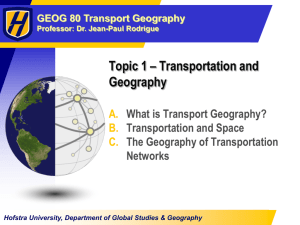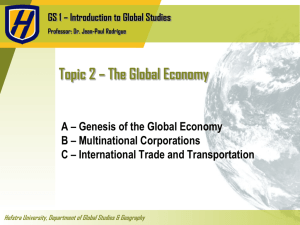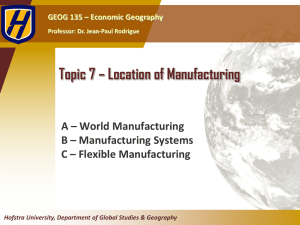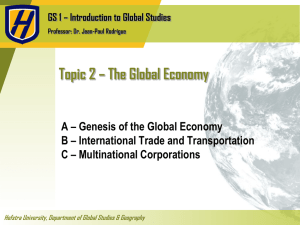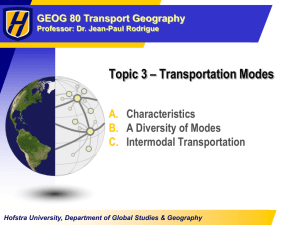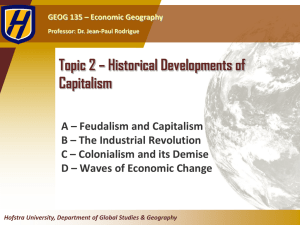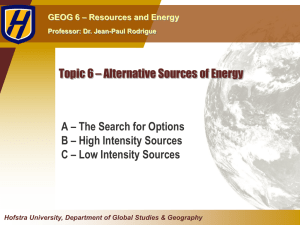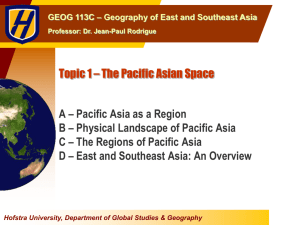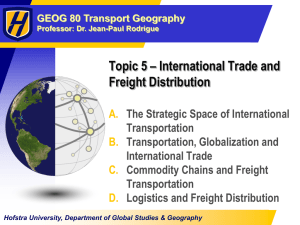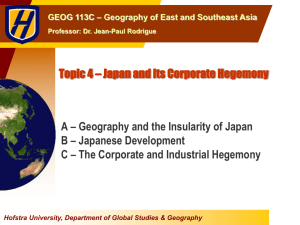Topic 1 * Overview of Economic Geography
advertisement
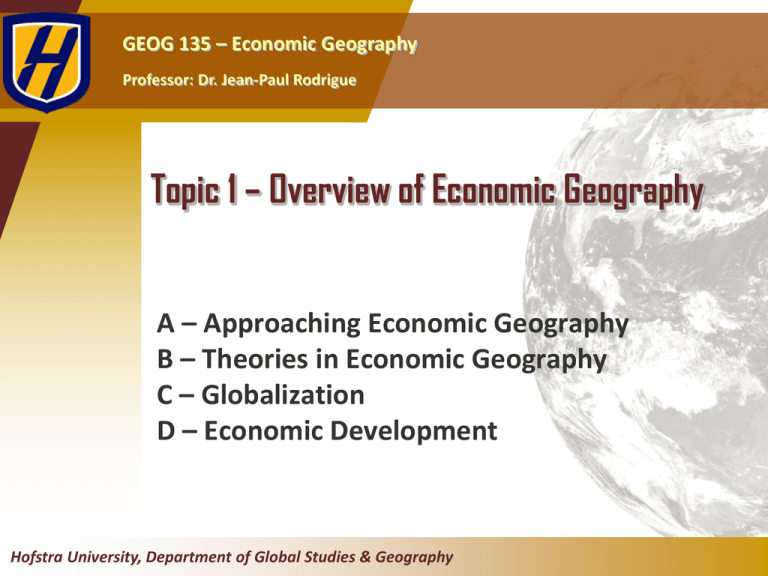
GEOG 135 – Economic Geography Professor: Dr. Jean-Paul Rodrigue Topic 1 – Overview of Economic Geography A – Approaching Economic Geography B – Theories in Economic Geography C – Globalization D – Economic Development Hofstra Department of Global Studies & Geography HofstraUniversity, University, Department of Global Studies & Geography The world is not random… the spatial order of the economy What is located where, why, how? © Dr. Jean-Paul Rodrigue Hong Kong Skyline (China) © Dr. Jean-Paul Rodrigue Container Yard, Veracruz (Mexico) © Dr. Jean-Paul Rodrigue A - APPROACHING ECONOMIC GEOGRAPHY 1. 2. Defining Economic Geography Themes for Approaching Economic Geography © Dr. Jean-Paul Rodrigue Economic Geography ■ Subdiscipline of geography concerned about: • The spatial organization and distribution of economic activity: • • • • Production (primary, secondary, tertiary) Transportation Communication Consumption • The use of the world’s resources. • The geographic origins, structure, and dynamics of the world economy. © Dr. Jean-Paul Rodrigue Global Manufacturing, 2009 © Dr. Jean-Paul Rodrigue Global Container Port and Air Cargo Traffic, 2008 © Dr. Jean-Paul Rodrigue Global Submarine Cable Network © Dr. Jean-Paul Rodrigue World’s Largest Cities and Human Development Index 2010 © Dr. Jean-Paul Rodrigue Economics and Economic Geography ■ Similar problems; different approaches • Economic geography: • Conceptualize economic issues in terms of space, place and scale. • Tend to be empirically based. • Economics: • Tends to homogenize the economic world. • The “market” is often considered as “aspatial”. • Main areas of investigation: • • • • • • • Technological change Geopolitics Cultural homogenization/localization Transport & communication cost reductions Fall of centrally planned economies Rise of global capital markets Institutions and governance World Bank, IMF, WTO, OPEC, OECD…. © Dr. Jean-Paul Rodrigue Themes for Approaching Economic Geography ■ (1) Historical specificity of geography • Difficult to separate spatial and temporal processes. • The current situation the outcome of past decisions: • • • • Firms Individuals Organizations Governments. • Economic geography is spatially and temporarily constructed. © Dr. Jean-Paul Rodrigue Spanish and Portuguese Empires (1581-1640) © Dr. Jean-Paul Rodrigue Themes for Approaching Economic Geography ■ (2) Interconnectedness of regions • Places do not exist in isolation from one another. • Networks of locations; implies links. • Types of linkages: • • • • Biophysical (e.g. winds, sea currents, pollution). People (e.g. migration, commuting). Capital (e.g. investments, remittances). Goods (e.g. trade, supply chains). • Power relations (e.g. trade agreements). © Dr. Jean-Paul Rodrigue Global Net Migration (2005-2010) © Dr. Jean-Paul Rodrigue Themes for Approaching Economic Geography ■ (3) Interpenetration of human and biophysical systems • Natural resources impact economic opportunities: • Climate, topography, soils, vegetation, minerals, water resources. • Agriculture, Mining, Logging. • People and economic activities also impact biophysical systems: • • • • • Irrigation. Deforestation. Desertification. Pollution. Climate change. • Long history of interdependencies since the agricultural revolution. © Dr. Jean-Paul Rodrigue Most Suitable Cereal © Dr. Jean-Paul Rodrigue Themes for Approaching Economic Geography ■ (4) Importance of culture in the creation of social and spatial relations • Influence of culture on economic behavior. • Culture dictates what is desirable and acceptable; consumption norms. • Political economy reflective of culture; distribution of power and wealth. • Gender relations. © Dr. Jean-Paul Rodrigue World’s Major Cultural Regions Slavic-Orthodox Western Confucian Islamic Hindu Latin American African Islamic Western © Dr. Jean-Paul Rodrigue B – THEORIES IN ECONOMIC GEOGRAPHY 1. 2. Location Theory Political Economy © Dr. Jean-Paul Rodrigue 1. Location Theory ■ Concept of location • Absolute location (coordinate system). • Relative location (referring to other locations) ■ Definition • Analyzing location decisions of firms and individuals. • What locates where? • Looking for a formulation / rules of behavior. • Why? © Dr. Jean-Paul Rodrigue Basic Location Factors Location Land, utilities, visibility, transportation (local access), amenities Labor, materials, energy, markets, suppliers / customers Capital, subsidies, regulations, taxation, technology Site Micro (local) Accessibility Socioeconomic Environment Meso (regional) Macro (national) © Dr. Jean-Paul Rodrigue 1. Location Theory ■ Relevance of geography • Location is a resource multiplier: • Using resources more effectively. • A city is a more effective production and consumption structure. • Some locations have higher sale potential; they differ mainly because of their accessibility. • Accessibility can be a proxy for the value of space. • A location can be a resource in itself: • Bottleneck rent effect on flows (canals, bridges, tunnels). • Capturing rent for right of passage (plus construction and maintenance of infrastructure). © Dr. Jean-Paul Rodrigue 2. Political Economy ■ Political economy • Investigation of power structure and wealth distribution within a society. • “Who gets what, when, where and why”. • Institutions behind this structure and distribution. ■ Main systems • Capitalist System: Power (suffrage), wealth (private). • Command Economies: Power (bureaucracy), wealth (state). • Traditional economies: Power (monarch), wealth (feudalism). © Dr. Jean-Paul Rodrigue 2. Political Economy ■ The rise of capitalism • The general demise of command and traditional economies in the face of globalization. • Economic geography as the study of capitalist landscapes: • • • • Private property. The search for innovation and efficiency. Profit as a driver (capital accumulation). Competition through processes and locations. • Capitalism emerged in the 15th century, diffused with colonialism and accelerated with globalization. © Dr. Jean-Paul Rodrigue The Circular Flow in the Capitalist System $ to pay for resources Goods & Services (consumption - resources) Businesses & Government (production) Goods & Services $ from product market (sales) Resource Market (prices) Income from work Labor (production - labor) Households (consumption) Savings & Investment: Capital Markets (sales) Product Market (prices) Goods & Services $ to pay for consumption Public Goods: Taxation & Provision © Dr. Jean-Paul Rodrigue World GPD, 2008 © Dr. Jean-Paul Rodrigue C – GLOBALIZATION 1. 2. Economic Globalization Transnational Corporations © Dr. Jean-Paul Rodrigue Major Forms of Globalization: A Multidimensional and Dynamic Concept Form Cultural / Social Political Economic Nature How globalization changed human behavior? What forms of regulation or control are linked with globalization? How globalization influences wealth creation and distribution? Outcomes Homogenization Hybridization Rejection Transnational agreements (global or regional) Trade, new markets, new products Issues Is a global culture emerging? Are forms of global governance suitable? Is globalization promoting inequalities? © Dr. Jean-Paul Rodrigue Main Possible Causes of Globalization Cause Dimension Technology Scientific standardization (weights and measures, time zones). Communication technology (mass communication, internet, electronic translation). Transport technology (air transport, containerization). Cultural Spread of ideologies (religions, democracy). Development of global events (Olympics, World Cup). Consumerism (global brands). Economic Voyages of exploration (15th – 17th centuries). Commercial policy (free trade). Expansion of trade and markets (comparative advantages). Multinational corporations (global production). Political Supra-national regulations (institutions facilitating international exchanges). Environmental consciousness (climate change, resource depletion). © Dr. Jean-Paul Rodrigue The Drivers of Globalization Integration Production Transportation Transactions Regulatory chains. Supply chains. Transport chains. Offshoring. Containerization. Information chains (ICT). Harmonization of regulatory regimes. Global production networks. Transborder transportation. Capital for investments. Trade agreements. Credit for transactions. © Dr. Jean-Paul Rodrigue Economic Integration Levels, 2011 © Dr. Jean-Paul Rodrigue Globalization: Elements of the Debate Pro-Globalization Anti-Globalization Main model Laissez-faire capitalism Socialism Trade Free-trade Fair-trade Growth Creates prosperity and opportunities Results in inequalities Culture Cultural fusion (promotion of positive cultural traits) Erode traditional cultures and promotes homogenization Relations Positive-sum Zero-sum Environment Lead to an efficient allocation of resources Promotes unsustainability Welfare Improvement in life expectancy and education Erosion of the middle class and exploitation of labor Politics Improve civil liberties and democracy Process subjugated by corporations © Dr. Jean-Paul Rodrigue Examples of Globalization in the Service Sector Sector Driver Response Retail Increase in disposable income Cultural homogenization Emergence of brand names Chain stores Global products Tourism Increase in disposable income Available leisure time Affordable air travel Mass tourism Chain hotels / resort areas Telecommunication Technological innovations (WWW, mobile) Privatization (mostly) Ubiquitous networks and access Global telecom carriers © Dr. Jean-Paul Rodrigue “Arabica Universalis” © Dr. Jean-Paul Rodrigue International Tourists Arrivals and Receipts, 1950-2010 1000 900 800 Arrivals (millions) Receipts (billions of $US) 700 600 500 400 300 200 100 0 © Dr. Jean-Paul Rodrigue Millions Diffusion of Telecommunication Services, 1985-2011 7,000 6,000 Cellular Phone Subscribers Fixed Broadband Subscriptions 5,000 4,000 3,000 2,000 1,000 0 © Dr. Jean-Paul Rodrigue 2. Transnational Corporations ■ Multinational corporation • A corporation that takes a global approach for: • Its inputs (raw materials, parts). • Its outputs (customers). • Different parts of the industrial system are located in places where they are the most productive. © Dr. Jean-Paul Rodrigue Types of Multinational Corporations Raw Materials Seekers Market Seekers Minimal Cost Seekers Lower input costs Economies of scale Comparative advantages Resource acquisition Expand market Lower production and distribution costs First MNCs to emerge Large investors Remain competitive © Dr. Jean-Paul Rodrigue The World’s 20 Largest Corporations by Market Value, 2011 ($US millions) AT&T Wal-Mart HSBC JP Morgan Chase China Mobile Gazprom IBM Nestle Berkshire Hathaway General Electric Microsoft Chevron Royal Dutch Shell China Construction Bank BHP Billiton Petrobas Industrial & Commerical Bank of China Apple PetroChina Exxon Mobil 0 50,000 100,000 150,000 200,000 250,000 300,000 350,000 400,000 450,000 © Dr. Jean-Paul Rodrigue World's 250 Largest Corporations by Head Office City © Dr. Jean-Paul Rodrigue D – ECONOMIC DEVELOPMENT 1. 2. The Notion of Development Wealth Disparities © Dr. Jean-Paul Rodrigue The Notion of Development ■ What is development? • Development is about people, not necessarily the economy. • Development is a process. • Improvement of the welfare of the population: • Create an enabling environment for people. • Long term process. ■ Conditions • Appropriate social conditions. • Appropriate political and legal conditions. • Appropriate economic conditions. © Dr. Jean-Paul Rodrigue The Notion of Development Outcomes Human Capital Physical capital Development -Health -Education -Quality of life -Rights -Equity -Rule of law -Employment -Surplus Conditions © Dr. Jean-Paul Rodrigue The Notion of Development ■ Physical capital • Infrastructures and resources that can be used in a productive manner. • Natural resources are not physical capital. • Include public utilities: • Energy, telecommunications, water supply and waste disposal. • Public works: • Roads, dams, irrigation canals. • Transport infrastructures: • Ports, airports, railways, public transit systems. © Dr. Jean-Paul Rodrigue The Notion of Development ■ Human capital • The total population and its qualification level. • Development of human capital: • Supported by education systems. • Reproduce and improve the productivity of the labor force. • Information economy: • Human capital a resource that differentiates nations. • Not always because of wage differences, but because of differences in the qualification level. © Dr. Jean-Paul Rodrigue Poverty and its Vicious Circle Poor Country Foreign Imports Low Purchasing Power Low Productivity Low Demand Limited Savings Foreign Loans Limited Investments © Dr. Jean-Paul Rodrigue 2. Wealth Disparities ■ The expression of needs • Wants versus needs. • Goods and services that population groups need: • Food, shelter, clothing, health care and water. • Expression of new needs: • Demographic growth. • Each level of development linked to a level of need from the population. • Consuming goods, energy, mobility and education • Demographic growth creates the most important needs. © Dr. Jean-Paul Rodrigue Basic Needs Food Health Education Context Basic caloric and nutritional requirement. 2,500 calories per day is the minimal intake for a working adult. Consumption of health services. Provide a level of Fundamental education to expression of insure continuity. comfort and status. Issues Population growth and changes in diet Aging of the population Advanced economies require a higher level of education. Faster spread vectors. Global information networks. Globalization Growing availability of food in quantity, quality and diversity. Housing Necessitate raw materials and infrastructure. © Dr. Jean-Paul Rodrigue 2. Wealth Disparities ■ Trends • Economic development is linked with global inequalities: • Reinforces the differences between countries and even within countries themselves. • The assets of the 200 richest people are more than the combined income of 41% of the world’s population. • Difference between those contributing to the generation of wealth and the excluded. • Ethnic origin, language, skills, etc. • Inequalities not linked with a particular political system: • In the US, the income of the poorest 20% has declined since the 1970s. • The income of the richest 20% has increased by 15%. • The income of the richest 1% has increased by 100%. © Dr. Jean-Paul Rodrigue Share of the World GDP, 2008 (Current USD) United States 20% Rest of the world 47% Japan 7% China 6% Germany 5% Other G8 15% © Dr. Jean-Paul Rodrigue Percentage of the Population Living on Less than $2 per Day, 19812002 100 90 80 70 60 50 40 30 20 10 0 1980 East Asia South Asia Sub-Saharan Africa 1985 1990 1995 2000 2005 © Dr. Jean-Paul Rodrigue Income of the 10% Richest and the 20% Poorest, c2005 Japan Highest 10% Lowest 20% Denmark Sweden Germany Canada India United States Russian Federation China Mexico Brazil Bolivia Haiti 0 10 20 30 40 50 © Dr. Jean-Paul Rodrigue
